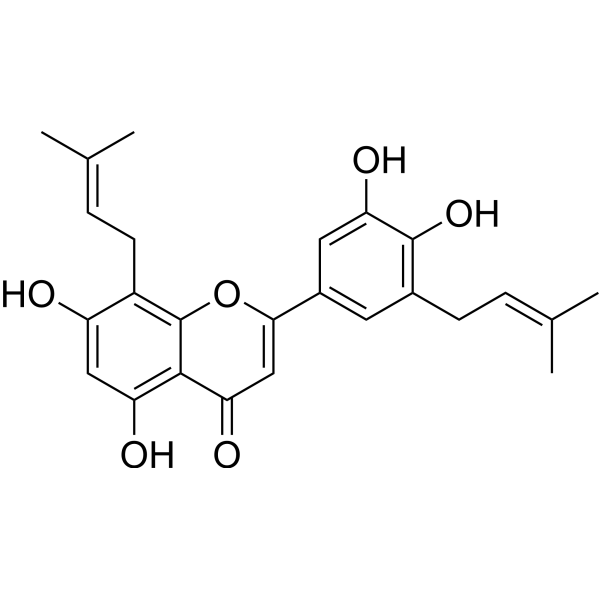All AbMole products are for research use only, cannot be used for human consumption.

Epimedokoreanin B is a natural flavonoid, which inhibits the growth of lung cancer cells through endoplasmic reticulum stress-mediated apoptosis accompanied by autophagosome accumulation. Epimedokoreanin B has anticancer, anti-inflammatory and antibacterial activity.
Epimedokoreanin B is an anti-periodontitis agent that inhibits gingipains and Porphyromonas gingivalis growth and biofilm formation. Epimedokoreanin B (3.13-25 μM; 48 hours) shows significate inhibitory effect on proliferation against lung cancer cell A549, Calu1 and H1299. Epimedokoreanin B inhibits M2 polarization in human monocyte-derived macrophages (HMDMs). Epimedokoreanin B suppresses STAT3 activation in HMDMs.
In vivo, Epimedokoreanin B (20 mg/kg; p.o.; thrice a week; for 17 days) inhibits tumor growth in an LM8 tumor-bearing murine model.
| Molecular Weight | 422.47 |
| Formula | C25H26O6 |
| CAS Number | 161068-53-7 |
| Solubility (25°C) | DMSO |
| Storage |
Powder -20°C 3 years ; 4°C 2 years In solvent -80°C 6 months ; -20°C 1 month |
| Related Anti-infection Products |
|---|
| Strictinin
Strictinin is a phenolic compound which has potential antiviral, antibacterial and laxative activities. Strictinin occurs by accelerating intestinal transit rather than enhancing gastric emptying, increasing food intake, or inducing diarrhea in rats. |
| Torcitabine
Torcitabine (2'-Deoxy-L-cytidine) is an antiviral agent. Torcitabine has the potential for chronic hepatitis B virus infection research. Torcitabine (2'-Deoxy-L-cytidine) shows greater inhibition of first strand than second strand DNA synthesis. |
| ABMA
ABMA is a broad-spectrum inhibitor of intracellular toxins and pathogens. ABMA efficiently protects cells against various toxins and pathogens including viruses, intracellular bacteria and parasite. |
| DDX3-IN-1
DDX3-IN-1 is a DEAD-box polypeptide 3 (DDX3) inhibitor with CC50 values of 50 and 36 μM for HIV and HCV, respectively. DDX3-IN-1 has antiviral activity. |
| K22
K22 is an inhibitor of coronavirus RNA synthesis that specifically targets membrane-associated coronavirus RNA synthesis. K22 effectively blocks replication of multiple coronaviruses by inhibiting the critical step of viral replication complex anchoring to host cell membranes to form double-membrane vesicles (DMVs). K22 exhibits broad-spectrum antiviral activity against diverse coronaviruses. |
All AbMole products are for research use only, cannot be used for human consumption or veterinary use. We do not provide products or services to individuals. Please comply with the intended use and do not use AbMole products for any other purpose.


Products are for research use only. Not for human use. We do not sell to patients.
© Copyright 2010-2024 AbMole BioScience. All Rights Reserved.
